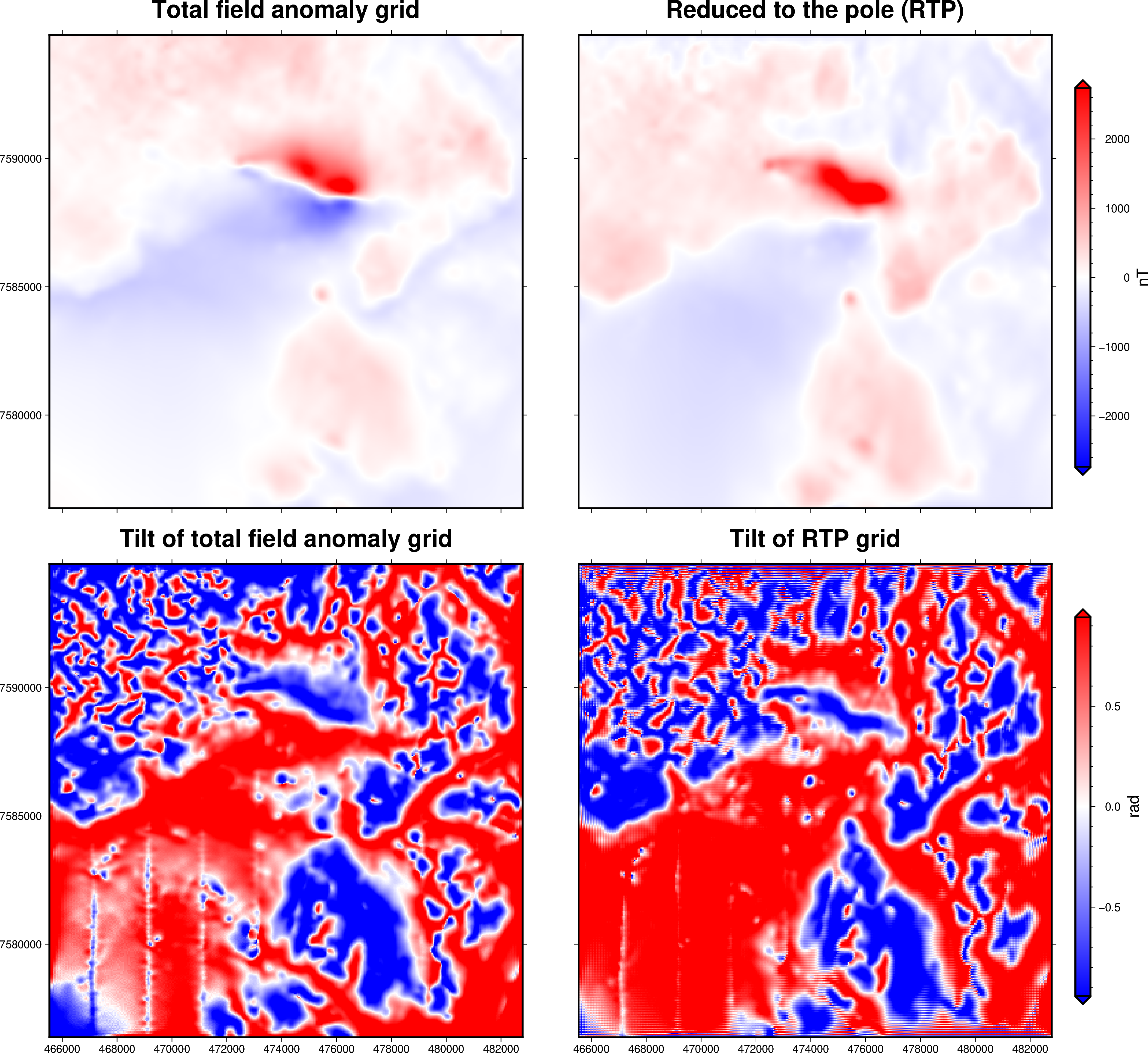Note
Go to the end to download the full example code
Tilt of a regular grid#

Tilt:
<xarray.DataArray (northing: 370, easting: 346)> Size: 1MB
array([[-1.0783784 , -1.02860717, -1.04340939, ..., 1.03827901,
1.02638371, 1.08973867],
[-1.03642874, -1.45715868, -1.48696672, ..., 1.51656355,
1.5129112 , 1.02828324],
[-1.04841707, -1.50371841, -1.54700707, ..., 1.51704351,
1.51441199, 1.04159331],
...,
[-1.10088333, -1.33804824, -1.31496059, ..., 0.32157698,
0.72592929, 1.35945242],
[-1.08740577, -1.34292621, -1.3185706 , ..., 0.24911404,
0.65291946, 1.37433697],
[-1.11194247, -1.03333203, -1.04572183, ..., -0.19281687,
0.64110985, 1.23484722]])
Coordinates:
* easting (easting) float64 3kB 4.655e+05 4.656e+05 ... 4.827e+05 4.828e+05
* northing (northing) float64 3kB 7.576e+06 7.576e+06 ... 7.595e+06 7.595e+06
Tilt from RTP:
<xarray.DataArray (northing: 370, easting: 346)> Size: 1MB
array([[-1.21333209, -1.4644687 , -1.46563213, ..., 1.42901118,
1.38962685, 1.02899332],
[-1.03471553, 0.11466866, -0.25452967, ..., -0.32908127,
0.13113278, 0.67459503],
[-1.17050374, -1.17608165, -1.29967283, ..., 1.33473239,
1.29156435, 0.91346865],
...,
[-1.2096313 , 0.31156962, -0.17243796, ..., 0.59752655,
0.97812607, 1.20524396],
[-1.21908118, -0.54733936, -0.90922684, ..., 0.17107842,
0.80343702, 1.21308321],
[-0.4247845 , 0.72898686, 0.59961164, ..., 1.04173936,
-0.14524941, 0.66491492]])
Coordinates:
* easting (easting) float64 3kB 4.655e+05 4.656e+05 ... 4.827e+05 4.828e+05
* northing (northing) float64 3kB 7.576e+06 7.576e+06 ... 7.595e+06 7.595e+06
import ensaio
import pygmt
import verde as vd
import xarray as xr
import xrft
import harmonica as hm
# Fetch magnetic grid over the Lightning Creek Sill Complex, Australia using
# Ensaio and load it with Xarray
fname = ensaio.fetch_lightning_creek_magnetic(version=1)
magnetic_grid = xr.load_dataarray(fname)
# Pad the grid to increase accuracy of the FFT filter
pad_width = {
"easting": magnetic_grid.easting.size // 3,
"northing": magnetic_grid.northing.size // 3,
}
# drop the extra height coordinate
magnetic_grid_no_height = magnetic_grid.drop_vars("height")
magnetic_grid_padded = xrft.pad(magnetic_grid_no_height, pad_width)
# Compute the tilt of the grid
tilt_grid = hm.tilt_angle(magnetic_grid_padded)
# Unpad the tilt grid
tilt_grid = xrft.unpad(tilt_grid, pad_width)
# Show the tilt
print("\nTilt:\n", tilt_grid)
# Define the inclination and declination of the region by the time of the data
# acquisition (1990).
inclination, declination = -52.98, 6.51
# Apply a reduction to the pole over the magnetic anomaly grid. We will assume
# that the sources share the same inclination and declination as the
# geomagnetic field.
rtp_grid_padded = hm.reduction_to_pole(
magnetic_grid_padded, inclination=inclination, declination=declination
)
# Unpad the reduced to the pole grid
rtp_grid = xrft.unpad(rtp_grid_padded, pad_width)
# Compute the tilt of the padded rtp grid
tilt_rtp_grid = hm.tilt_angle(rtp_grid_padded)
# Unpad the tilt grid
tilt_rtp_grid = xrft.unpad(tilt_rtp_grid, pad_width)
# Show the tilt from RTP
print("\nTilt from RTP:\n", tilt_rtp_grid)
# Plot original magnetic anomaly, its RTP, and the tilt of both
region = (
magnetic_grid.easting.values.min(),
magnetic_grid.easting.values.max(),
magnetic_grid.northing.values.min(),
magnetic_grid.northing.values.max(),
)
fig = pygmt.Figure()
with fig.subplot(
nrows=2,
ncols=2,
subsize=("20c", "20c"),
sharex="b",
sharey="l",
margins=["1c", "1c"],
):
scale = 0.5 * vd.maxabs(magnetic_grid, rtp_grid)
with fig.set_panel(panel=0):
# Make colormap of data
pygmt.makecpt(cmap="polar+h", series=[-scale, scale], background=True)
# Plot magnetic anomaly grid
fig.grdimage(
grid=magnetic_grid,
projection="X?",
cmap=True,
frame=["a", "+tTotal field anomaly grid"],
)
with fig.set_panel(panel=1):
# Make colormap of data
pygmt.makecpt(cmap="polar+h", series=[-scale, scale], background=True)
# Plot reduced to the pole magnetic anomaly grid
fig.grdimage(
grid=rtp_grid,
projection="X?",
cmap=True,
frame=["a", "+tReduced to the pole (RTP)"],
)
# Add colorbar
label = "nT"
fig.colorbar(
frame=f"af+l{label}",
position="JMR+o1/-0.25c+e",
)
scale = 0.6 * vd.maxabs(tilt_grid, tilt_rtp_grid)
with fig.set_panel(panel=2):
# Make colormap for tilt (saturate it a little bit)
pygmt.makecpt(cmap="polar+h", series=[-scale, scale], background=True)
# Plot tilt
fig.grdimage(
grid=tilt_grid,
projection="X?",
cmap=True,
frame=["a", "+tTilt of total field anomaly grid"],
)
with fig.set_panel(panel=3):
# Make colormap for tilt rtp (saturate it a little bit)
pygmt.makecpt(cmap="polar+h", series=[-scale, scale], background=True)
# Plot tilt
fig.grdimage(
grid=tilt_rtp_grid,
projection="X?",
cmap=True,
frame=["a", "+tTilt of RTP grid"],
)
# Add colorbar
label = "rad"
fig.colorbar(
frame=f"af+l{label}",
position="JMR+o1/-0.25c+e",
)
fig.show()
Total running time of the script: (0 minutes 1.091 seconds)